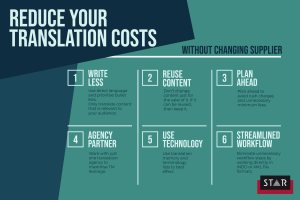January can be a strange month. The new year brings a metaphorical clean slate. We feel that now is our chance to change anything we choose.
Yet, at the same time, we spend a lot of our time musing on the previous year. Did we achieve everything we set out to do? Is there anything we should do differently going forward?
With all this in mind, January seems to be a great time to look at your translation purchasing and look for ways to reduce translation costs. It might be easier than you think to save money on translation.
Cheap is not necessarily cheapest
Before you start scouring the internet for a new translation supplier in an effort to reduce translation costs, I’m here to tell you that it’s not necessary.
Sure, some translators are cheaper than others, but this doesn’t give the whole picture.
At the same time as looking at the invoice costs, consider the value provided by your translation supplier.
In many cases, a professional translation agency offers additional services, such as proofreading and quality checks.
Using a non-professional translator or a freelancer might be a way to reduce translation costs, but this could have a negative impact on the translation quality.
Instead, this blog article will look at ways to reduce translation costs by optimising your text and your processes.
Write less
Professional translations are usually priced on a per-word basis. We touched on this in our Translation 101 and looked at it in more detail in an earlier blog post.
If you are looking to reduce translation costs, reducing the number of words in your project is a simple place to start.
Of course, I’m not suggesting that you omit important information in your quest to reduce translation costs. However, there are two things to look at here:
- Is your text repetitive or very wordy?
You can reduce translation costs by removing repetitive warnings, ensuring that you use direct language wherever possible, and by using bullet point lists rather than long paragraphs of explanation. - Is all of your content relevant to all markets?
If you are localising your website for a new audience, you can easily reduce translation costs by being discerning about which content you choose to translate.
You could choose to only translate information about certain product lines, or to be selective with case studies or blog articles.
Reuse more
A simple way to reduce translation costs is to increase translation memory reuse.
Translation memory software stores “segments” of text so that they can be reused by translators in future projects. It looks for exact matches and partial matches from your content.
Increasing the amount of pretranslated matches and reducing the amount of completely new content is a sure-fire way to reduce your translation costs.
This will not be possible for every project. Information about a brand-new product is likely to be mainly new content, however, technical manuals, safety information and even marketing campaigns can include similar content.
For example, every technical manual contains warnings and safety information. Any warnings or safety information that are common to multiple products can be directly copied. When it comes to translation, they will be pretranslated matches and will cost less. A simple way to reduce translation costs!
To give another example, if a marketing campaign comprises web banners, print ads and point of sale collateral, the same slogan and taglines will appear on each item.
Another facet of increasing leverage from translation memory in order to reduce translation costs is to restrict editing.
It can be tempting to make a few tweaks to existing content to “freshen it up”. Or even to “improve” on a colleague’s work. Yet these small changes can quickly lead to considerable cost increases.
Look after the pennies
Changing one word in a ten-word sentence will cause the whole sentence to be considered as a partial match, rather than a complete match. Depending on the pricing structure, this could cause the cost for that one sentence to double or even triple.
Although we are talking about “mere pennies” for each sentence, the costs quickly spiral if that one sentence is translated to multiple languages and similar edits appear throughout your document.
Over a year, the additional (and potentially unnecessary) costs could reach hundreds of pounds.
My last point in this section is to create “translation-friendly content”. My internal jargon alarm just sounded as I typed that, so I’ll explain further.
You are looking to write content that is easy to translate and that is more likely to deliver translation memory matches in future projects:
- Shorter sentences
- Consistent grammatical structure
- Make sure there are no typos or grammar errors
- Use the same terminology throughout
Fail to plan, plan to fail?
It might not be immediately obvious how planning can help reduce translation costs. For me, there are three points to consider here.
It is not always possible to avoid projects with short turnarounds. Life happens and sometimes, delays are inevitable. When you have a fixed publish deadline and limited time for translation, it is common practise for agencies to charge a rush fee for the project.
Sometimes these are a flat fee, but more often, they are a percentage charge on top of the translation cost.
Sending a quick heads-up to your translation agency partner to let them know about the project might help you to avoid these and thereby reduce your translation costs. Simply tell them how big the project is and when you need it for.
They should be able to tell you how long they would need for translation so you can factor this into your schedule. If you already know that the turnarounds will be short, they may be able to suggest ways of working that will help you to meet these tight deadlines.
Incur a minimum number of minimum fees
Generally speaking, a minimum fee is incurred when the total number of chargeable words within a project is below a certain threshold. Your translator will always do a certain amount of project admin, regardless of whether the project contains 10 or 10,000 words. The minimum fee is used to cover their time for this admin work.
If you send 10 words every day, then it’s possible that you will be charged a minimum fee every day. These can quickly add up, and for anyone looking to reduce translation costs, reducing minimum fees should be a priority.
Planning ahead is key in this regard.
If your recurring minimum fees are short social media posts, then collecting every post that you intend to publish within a month can be a simple way to avoid multiple minimum fees and reduce translation costs.
Or, perhaps your recurring minimum fees are additional buttons or labels from a larger project. It is easy to overlook text, or to have additional requirements appear at last minute. At STAR UK, we’re happy to gather all of these labels into one minimum fee over a period of time. All you need to do is give us a little bit of prior warning.
Use white space wisely
My final point in this section is that you can reduce your translation costs by planning your document layouts carefully.
What?! I hear you say. How does that work?
I have touched on this in a few previous blog posts; text expands and contracts depending on the language combination. For example, a paragraph in German will take up more space than the same paragraph translated into English.
By allowing space for your translations to expand into, you reduce the DTP requirement for your documents, thereby reducing your translation costs.
Just one translation supplier
Working with just one agency partner is a simple way to reduce your translation costs.
Every translation agency builds up their own store of translation memory for their customers and they use it for each project that they receive from them. Although you might think that it is beneficial to you to use one agency for technical texts and another for marketing texts, there can be a surprising amount of overlap between the two.
This feeds into my point about reusing as much as possible – agency A cannot reuse material that is stored by agency B; they don’t know it exists!
Working with one agency can also reduce your translation costs over time. Long-term partnerships lead to better knowledge of your projects and your material. Your agency partner will be familiar with how you work and they might be able to suggest process improvements that you have not previously considered.
Use technology to your advantage
Again, I touched on this one already. Translation technology was designed with the aim of reducing translation costs by speeding up translation and aiding reuse of existing material.
Using editable files allows this translation memory software to be used. You can easily build up stores of reference material for future projects that will help to reduce your translation costs in the future.
It’s important when looking at your editable files to make sure that all of the text is editable. Picture labels might be embedded in images and therefore not recognised by the translation software. In these cases, there may be additional charges for DTP work, or minimum fees to deal with the missed text.
Streamlined workflow
My last point for this post actually relates to your own workflow as a customer, rather than ours as a supplier. Making workflow changes internally will obviously not reduce translation costs directly, yet you might be surprised at how much time you can free up with just a few small amends.
So, is your internal workflow as streamlined as it could be?
One key tip that I could offer at this point is to make sure that you are working in the final file type. Rather than copying your InDesign or web copy into an MS Word file for translation, try asking your agency partner to work directly in the INDD or XML files.
You could save yourself many long hours of copy-pasting!
The same applies for using your own multilingual staff to work on translation tasks. In many cases, they were not originally hired as a translator so they already have a full schedule of tasks to complete. If your employee is working on translation work, they are not working on their main tasks.
The above points are only a few examples of cost-saving measures, but I hope they prove that your first step should not be to change supplier. In my experience, most customers can see immediate cost savings by implementing one or several of these tips.





